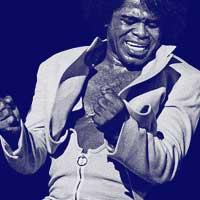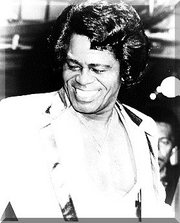James Brown Biography - A Very Quick Guide
James Brown (born May 3, 1933, Barnwell, South Carolina — some sources list his year of birth as 1928 and his birthplace as Pulaski, Tennessee) is one of the most important figures in twentieth-century music and a prime influence in the evolution of gospel and rhythm and blues into soul and funk. As a singer, dancer and bandleader, he has influenced popular musicians since the 1960s. He has been cited as an influence by musicians in many genres, including rock, soul, jazz, R&B, and hip-hop. Among other things, his quick ascent to icon status in the musical community can be attributed to his rejection of industry stereotypes. Also, Soul Brother Number One was a symbol of self-motivation and achievement in spite of racism for Black Americans.
James Brown's musical innovations, developed in tandem with the many skilled musicians who passed through his bands (the Flames, the James Brown Band, the JB's), used the basic building blocks of earlier African-American music; his career is a case study in change and self-determination. In the late 1960s and early 1970s, his irresistible sound spawned countless imitators. By the mid- '70s, several of his key band members (Bootsy Collins, Fred Wesley, and Maceo Parker), had left his employ and joined forces with George Clinton, whose so-called P-Funk groups (Funkadelic, Parliament, Parlet, the Brides of Funkenstein) were a looser, wilder and more self-consciously counterculture version of Brown's bands. With the advent of hip hop in the late '70s, James Brown's grooves became the foundation for rap music and breakdancing, as DJs such as Grandmaster Flash looped and extended the drum breaks from earlier JB favorites like 'Give It Up Or Turn It A Loose.' In the late 1980s, James Brown's music experienced a renaissance with the rise of sampling by Hip Hop producers. Snippets of his 800-some songs were recycled into hundreds of rap songs and continue to appear in electronic music to this day.
| Contents |
Biographical Information
Brown grew up in the poverty of Depression era Augusta, Georgia. At 16, he was convicted of armed robbery and made the acquaintance of Bobby Byrd. He secured an early release after three years with the help of Byrd's family under the condition that he not return to Augusta or Richmond County and that he would try to get a job. After a brief stint as a boxer and then baseball pitcher ended by a leg injury, Brown turned his energy toward music, transforming the vocal band The Gospel Starlighters into the first generation of The Famous Flames.
The Sixties
He began to tour relentlessly (Brown often calls himself The Hardest Working Man In Show Business) and the band built a following with their live shows. Brown's early hits, such as 'Please Please Please,' recorded 1956, and 'I'll Go Crazy,' recorded 1959, were fairly straightforward gospel and R&B compositions marked by a rhythmic acuity and sharpness of vocal and instrumental attack that would later become even more pronounced and would lead to the style called 'funk'. Brown's trademark screams and stage act are renowned for generating a positive and highly excited response from the audience. While these early singles were local hits, and performed well on the R&B chart, the band was not nationally successful until this live show was captured on record, on Brown's self-financed Live at the Apollo in 1963. During this time Brown recorded for the Cincinnati, Ohio-based King Records, presided over by Syd Nathan.
Brown followed this success with a string of singles that, along with the work of Allen Toussaint in New Orleans, essentially defined funk music. 1964's 'Out of Sight' was a harbinger of the new James Brown sound. 'Papa's Got A Brand New Bag' and 'I Got You (I Feel Good),' both from 1965, featured the deceptively simple riffs of guitarist Jimmy Nolen, which played off the bass guitar and drums. In addition, 'Papa's Got a Brand New Bag' saw Brown utilizing technology; the released version of the single was sped up to make the song more commercial. 'Cold Sweat' (1967) marked a radical departure into more abstract music, and critics have come to see this recording as a high mark in the music of the 1960s, although at the time the innovations of Brown were overshadowed by the work of the Beatles. Brown employed musicians and arrangers who had come up through the jazz tradition. He was noted for his ability as a bandleader and songwriter to marry the simplicity and drive of R&B to the rhythmic complexity and precision of jazz. Mixed in with his more famous rhythmic essays of the era were ballads and even Broadway show tunes. As the 1960s progressed, Brown would refine this style further with 'Licking Stick-Licking Stick' (recorded in 1968), and 'Funky Drummer' (recorded in 1969). He would also add socio-political commentary on songs like 'Say It Loud (I'm Black and I'm Proud)' (1968) and 'I Don't Want Nobody to Give Me Nothing (Open Up the Door I'll Get It Myself)' 1970)
The Seventies
By 1970 and his 'Get Up (I Feel Like Being) a Sex Machine' (recorded in Nashville, Tennessee), his 'classic' '60s band, featuring guitarist Jimmy Nolen, saxophonist Maceo Parker, and trombonist Fred Wesley, had left him, and he employed a new band that included Bootsy Collins, and later, Fred Wesley (as trombonist and musical director). As Brown's musical empire grew (he bought radio stations in the late 1960s), his desire for financial and artistic independence grew as well. In the early 70s he began recording for Polydor Records, and many of his sidemen and supporting players, such as Fred Wesley (and the JB's, Brown's backing group), Bobby Byrd, Lyn Collins, Myra Barnes and Hank Ballard, released records on Brown's subsidiary label, People, which started up in 1971. These recordings are as much a part of Brown's legacy as those released under his own name, and most are noted examples of what might be termed James Brown's 'house' style. The early 70s marked the first real awareness, outside the African-American community, of Brown's achievements; Miles Davis and other jazz musicians began to cite Brown as a major influence on their styles.
By the mid-70s Brown's star-status was on the wane. His 70s Polydor recordings were a summation of all the innovation of the last twenty years, and while some critics maintain that he declined artistically during this period, compositions like 'Funky President,' 'The Payback,' and 'Stoned to the Bone' are among his best. Nevertheless, key musicians such as Bootsy Collins began to depart. Ironically, the disco movement, which Brown anticipated, and some say originated, found relatively little room for Brown; his 1976 albums Get Up Offa That Thing and Bodyheat were his first flirtations with disco-fied rhythms incorporated into his funky repertoire. While 1977's Mutha's Nature and 1978's Jam 1980's generated no charted hits, 1979's The Original Disco Man LP is nonetheless a worthy late addition to his oeuvre, containing the song 'It's Too Funky in Here,' which was his last top R&B hit of the 70s.
The Eighties to the Present
In 1985 he managed another hit single, 'Living In America,' but in 1988, he was arrested following a high-speed car chase through the streets of Augusta. Imprisoned for firearms and drugs offences, as well as for the repercussions of his flight, he was released in 1991 to find the sampled rhythms and drum beats from his records almost ubiquitous in rap music; a 20-second drum solo near the end of the song 'Funky Drummer' is perhaps the single most sampled piece of music in history. Brown still makes his home in the Augusta area, and is a prominent figures in that community. A street in downtown Augusta is named James Brown Boulevard in his honor.
Brown was a recipient of Kennedy Center Honors for 2003, and a scheduled 2004 unveiling of a statue of Brown in Augusta was delayed because of James Brown's ongoing legal problems.
The 1991 four-CD retrospective Star Time is a synopsis of his career; nearly all his earlier LPs have been re-released on CD, often with additional tracks and informed commentary by scholars familiar with Brown. In short, James Brown's reputation as an innovator is now commonplace, and his personal appearances still draw crowds; a testament to his stature as both musician and entertainer.
In December 2004 Brown was diagnosed with prostate cancer which was successfully treated with surgery.
Samples
- Download sample of 'Papa’s Got a Brand New Bag'
External links
- James Brown - Godfather of Soul (http://www.godfatherofsoul.com/), Brown's official site.
- DMoz (http://dmoz.org/Arts/Music/Styles/Rhythm_and_Blues/Funk/Bands_and_Artists/Brown,_James/), listing of James Brown sites.
- Interview with James Brown (http://www.guardian.co.uk/g2/story/0,3604,1229299,00.html) - June 2, 2004 - The Guardian Newspaper (UK) (http://www.guardian.co.uk)
- James Brown (http://www.allmusic.com/cg/amg.dll?p=amg&sql=11:ntknu3t5an1k) at the All Music Guide
Top Pieces on 8notes by James Brown

